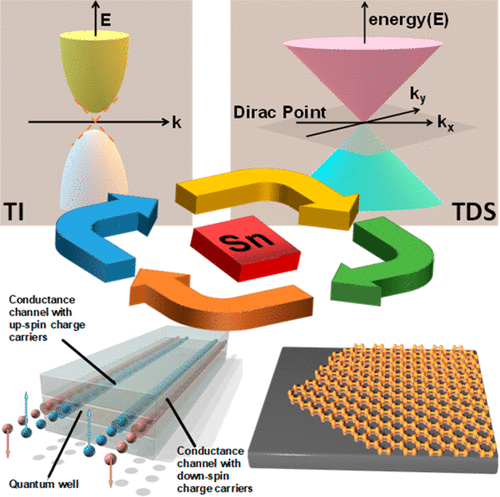当前位置:
X-MOL 学术
›
J. Phys. Chem. Lett.
›
论文详情
Our official English website, www.x-mol.net, welcomes your
feedback! (Note: you will need to create a separate account there.)
Recent Advances in Tin: From Two-Dimensional Quantum Spin Hall Insulator to Bulk Dirac Semimetal.
The Journal of Physical Chemistry Letters ( IF 4.8 ) Pub Date : 2020-02-04 , DOI: 10.1021/acs.jpclett.9b03538 Nan Si 1 , Qi Yao 2, 3 , Yixuan Jiang 1 , Heping Li 4 , Dechun Zhou 1 , Qingmin Ji 1 , Han Huang 5 , Hui Li 4 , Tianchao Niu 1
The Journal of Physical Chemistry Letters ( IF 4.8 ) Pub Date : 2020-02-04 , DOI: 10.1021/acs.jpclett.9b03538 Nan Si 1 , Qi Yao 2, 3 , Yixuan Jiang 1 , Heping Li 4 , Dechun Zhou 1 , Qingmin Ji 1 , Han Huang 5 , Hui Li 4 , Tianchao Niu 1
Affiliation

|
An atomic layer of tin in a buckled honeycomb lattice, termed stanene, is a promising large-gap two-dimensional topological insulator for realizing room-temperature quantum-spin-Hall effect and therefore has drawn tremendous interest in recent years. Because the electronic structures of Sn allotropes are sensitive to lattice strain, e.g. the semimetallic α-phase of Sn can transform into a three-dimensional topological Dirac semimetal under compressive strain, recent experimental advances have demonstrated that stanene layers on different substrates can also host various electronic properties relating to in-plane strain, interfacial charge transfer, layer thickness, and so on. Thus, comprehensive understanding of the growth mechanism at the atomic scale is highly desirable for precise control of such tunable properties. Herein, the fundamental properties of stanene and α-Sn films, recent achievements in epitaxial growth, challenges in high-quality synthesis, and possible applications of stanene are discussed.
中文翻译:

锡的最新进展:从二维量子自旋霍尔绝缘体到块状狄拉克半金属。
弯曲的蜂窝状晶格中锡原子层称为锡,是实现室温量子自旋霍尔效应的一种有前途的大间隙二维拓扑绝缘体,因此近年来引起了极大兴趣。由于Sn同素异形体的电子结构对晶格应变敏感,例如,Sn的半金属α相可以在压缩应变下转变成三维拓扑狄拉克半金属,因此最近的实验进展表明,不同衬底上的锡层也可以承载各种与面内应变,界面电荷转移,层厚度等有关的电子特性。因此,非常需要全面了解原子尺度上的生长机理,以精确控制这种可调特性。在这里
更新日期:2020-02-06
中文翻译:

锡的最新进展:从二维量子自旋霍尔绝缘体到块状狄拉克半金属。
弯曲的蜂窝状晶格中锡原子层称为锡,是实现室温量子自旋霍尔效应的一种有前途的大间隙二维拓扑绝缘体,因此近年来引起了极大兴趣。由于Sn同素异形体的电子结构对晶格应变敏感,例如,Sn的半金属α相可以在压缩应变下转变成三维拓扑狄拉克半金属,因此最近的实验进展表明,不同衬底上的锡层也可以承载各种与面内应变,界面电荷转移,层厚度等有关的电子特性。因此,非常需要全面了解原子尺度上的生长机理,以精确控制这种可调特性。在这里











































 京公网安备 11010802027423号
京公网安备 11010802027423号